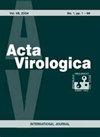菜豆αendornavirus-1在斯洛伐克的大豆种质中很常见,并且表现出低分子变异性
IF 0.8
4区 医学
Q4 VIROLOGY
引用次数: 1
摘要
在斯洛伐克西部花园中生长的两种豆类植物(Phaseouls vulgaris L.)的病毒组中,通过核糖贫化总RNA高通量测序鉴定了Phaseolus vulgariaαendornavirus-1(PvEV-1,内核糖核酸病毒科)。组装了两个几乎完整的PvEV-1基因组(约14.06kb,命名为PV1和PV2),显示99.9%的核苷酸同一性,与参考PvEV-1基因组(NC_039217)的核苷酸同源性达到98.4%。随后对PvEV-1在斯洛伐克的存在进行了研究,重点研究了两组样本:1)在开阔地条件下生长并在植被期取样的豆类植物;2)从斯洛伐克和法国豆类种质收集中获得的种子中生长的豆类材料。根据RT-PCR结果,来自开阔地的15份豆类样品中有4份和来自精选种质收藏的21份豆类材料中有12份检测出PvEV-1阳性。有趣的是,RT-PCR产物的测序显示,所有扩增的分离株在两个扩增的基因组部分中是相同的,这也与PV1和PV2分离株的基因组部分相同。这些结果表明斯洛伐克豆类中PvEV-1的发病率相对较高。这是欧洲首次从豆类植物中获得PvEV-1的证据和特征。本文章由计算机程序翻译,如有差异,请以英文原文为准。
Phaseolus vulgaris alphaendornavirus-1 is frequent in bean germplasm in Slovakia and shows low molecular variability
Phaseolus vulgaris alphaendornavirus-1 (PvEV-1, family Endornaviridae) was identified by ribodepleted total RNA high-throughput sequencing in the virome of two bean plants (Phaseouls vulgaris L.) grown in a garden in western Slovakia. Two nearly complete PvEV-1 genomes (ca. 14.06 kb, named PV1 and PV2) were assembled, showing 99.9% nucleotide identity, while their nucleotide identity with the reference PvEV-1 genome (NC_039217) reached 98.4%. Two primer pairs spanning the viral helicase encoding region and sequence upstream of the RNA-dependent RNA polymerase were designed and used to confirm the presence of the virus in the original bean samples by RT-PCR. A subsequent search for PvEV-1 presence in Slovakia was focused on two groups of samples: 1) bean plants grown under open field conditions and sampled during the vegetation period and 2) bean accessions grown from seeds obtained from a Slovak and French bean germplasm collection. Based on RT-PCR results, 4 out of 15 bean samples from open fields and 12 out of 21 bean accessions from the curated germplasm collection tested PvEV-1-positive. Interestingly, sequencing of RT-PCR products revealed that all amplified isolates are identical in the two amplified genomic portion which is also identical to those of the PV1 and PV2 isolates. These results suggest a relatively high incidence of PvEV-1 in bean in Slovakia. This is the first evidence and characterization of PvEV-1 from bean plants in Europe.
求助全文
通过发布文献求助,成功后即可免费获取论文全文。
去求助
来源期刊

Acta virologica
医学-病毒学
CiteScore
3.10
自引率
11.80%
发文量
43
审稿时长
>12 weeks
期刊介绍:
Acta virologica is an international journal of predominantly molecular and cellular virology. Acta virologica aims to publish papers reporting original results of fundamental and applied research mainly on human, animal and plant viruses at cellular and molecular level. As a matter of tradition, also rickettsiae are included. Areas of interest are virus structure and morphology, molecular biology of virus-cell interactions, molecular genetics of viruses, pathogenesis of viral diseases, viral immunology, vaccines, antiviral drugs and viral diagnostics.
 求助内容:
求助内容: 应助结果提醒方式:
应助结果提醒方式:


